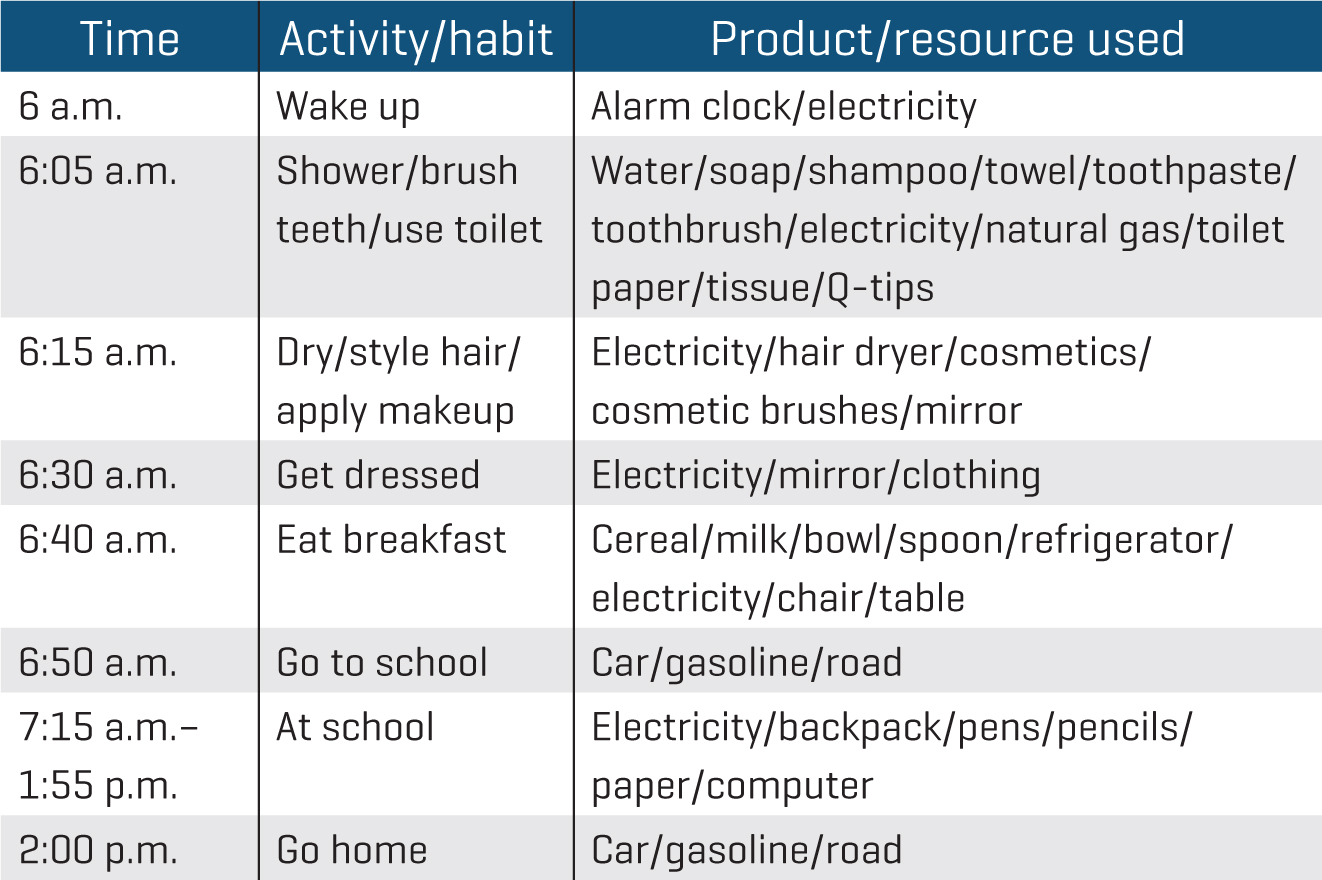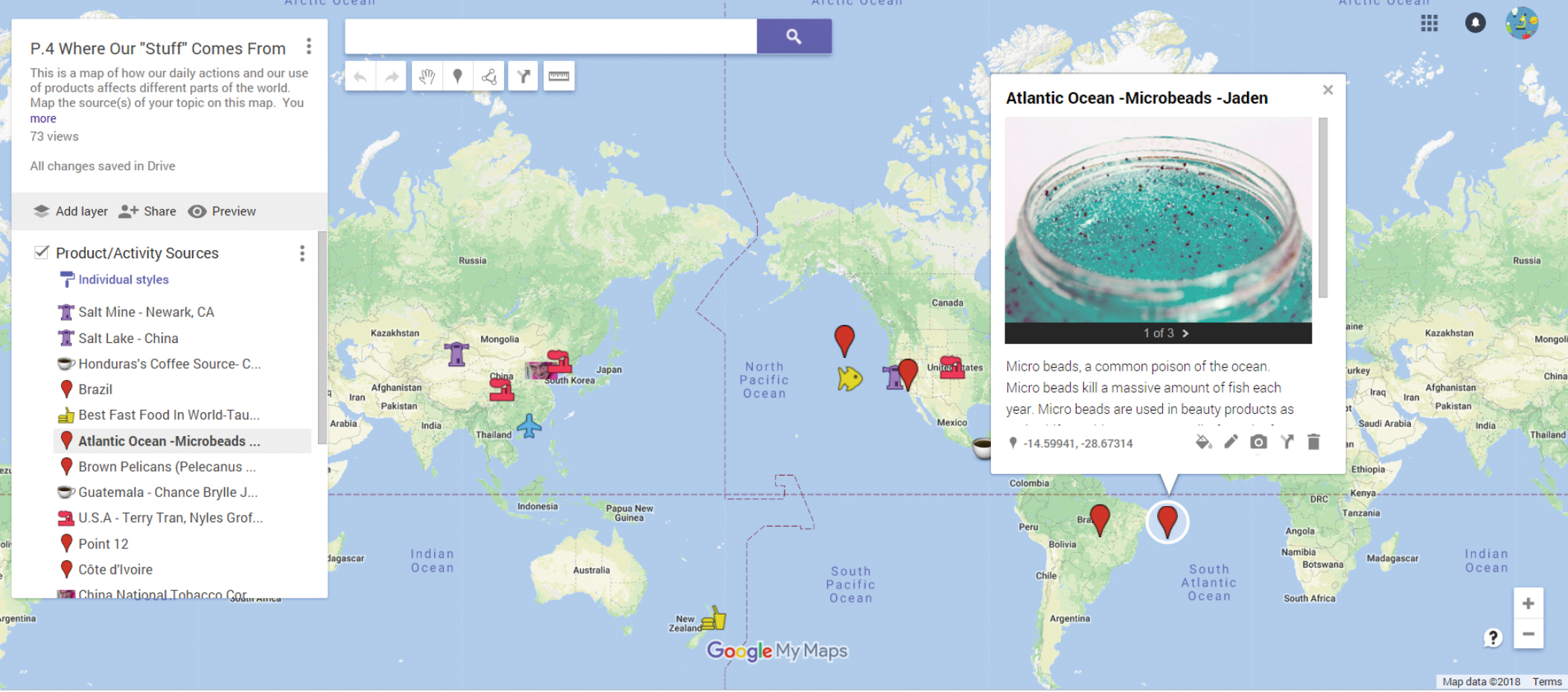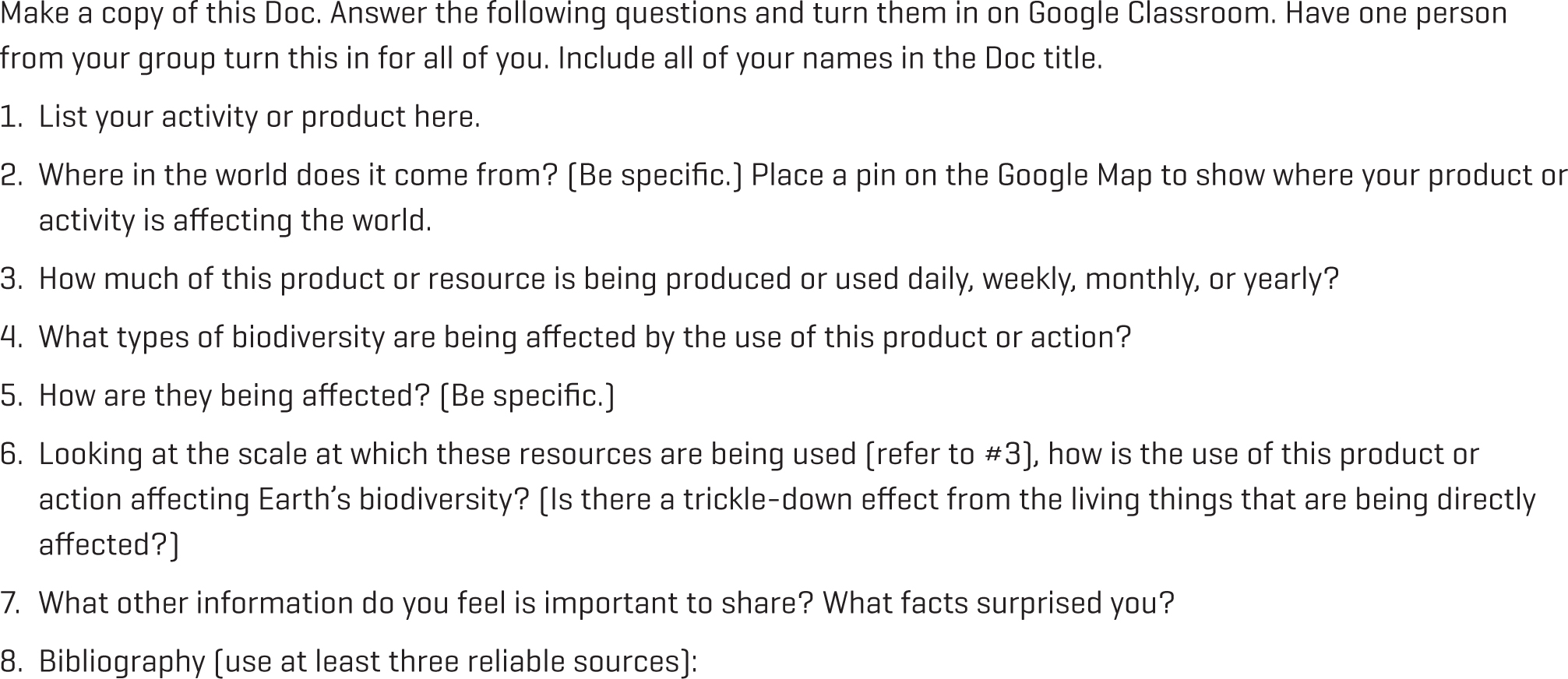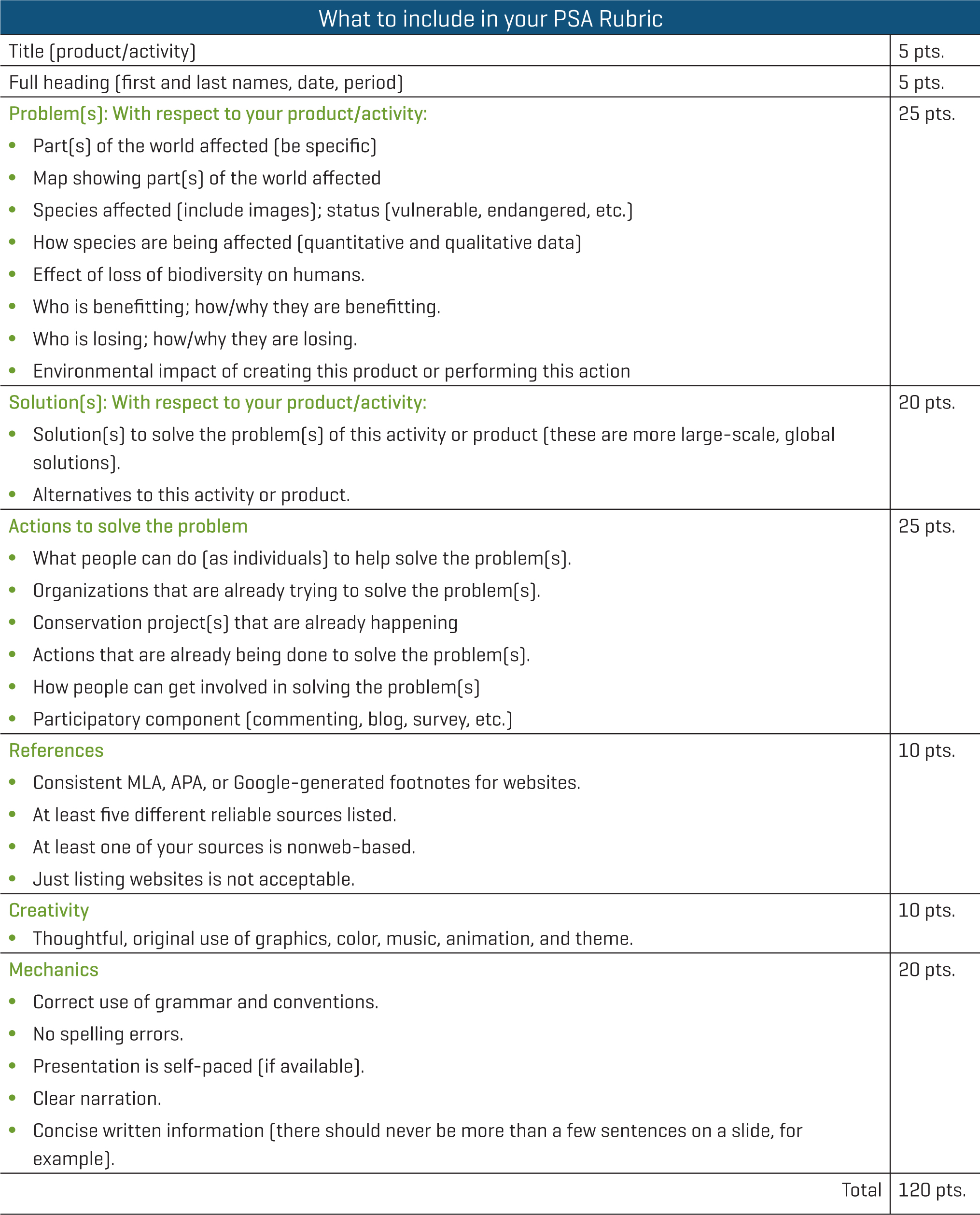Classic Lessons 2.0
How our daily lives affect biodiversity
How our daily lives affect biodiversity
By Jodi Takei
Updating Perennial Classroom Favorites
Even though numerous species are experiencing habitat degradation and loss, decreased genetic diversity, population declines, and extinction, people often overlook the effects that their daily lives have on the environment and on Earth’s biodiversity. This article describes a 9- to 12-day unit that helps students understand the impact of human activities on Earth’s resources and also inspires students to find solutions to reduce negative anthropogenic effects in order to conserve Earth’s biodiversity.
Engage: What are my daily activities?
Students are first asked to think about their daily schedule, from waking up in the morning to going to bed at night. Then they make a list of their daily habits, such as the products they use, the foods they eat, the clothes they wear, their energy consumption habits, and how they use water (see Figure 1, p. 14). Students then choose one habit, product, or action to focus on and write down where they think their product or activity comes from or what part of the world is most affected by the production or use of the activity or product. For example, hamburger patties are made from beef. Raising cattle requires massive amounts of land, water, food, and energy and produces methane gas, a potent type of greenhouse gas. This results in global warming and is mainly affecting developing regions of Asia, Africa, and Latin America, all of which are home to large some of the largest concentrations of biodiversity in the world. The teacher can have students can share their initial thoughts with the class.

Explore: How do my daily activities affect Earth’s biodiversity?
Next, students research the source of their chosen habit, product, or action. For example, where does the wheat, beef, and produce come from in their hamburger? Or, where does the cotton in their favorite shirt come from? What country is the shirt manufactured in? This portion of the lesson is very adaptable to meet the needs of their students. The teacher can choose to include as many topics and as much of the supply chain as he or she desires, such as the obtaining or mining of materials, transportation of products, packaging and merchandising, and marketing or selling. In addition, the list of products or activities can be condensed so that the teacher can provide websites for students to do their research. In doing so, the teacher can preview the information to gain background knowledge and to ensure that the research comes from reliable resources.
Through their research, students begin to understand what part of the world is affected by their chosen activity and the environmental implications of their habit or product. Students can compare what they are learning with their initial thoughts, making note of how their knowledge and understanding has changed. Next, students place a pin on a shared Google Map to show what part of the world is most affected by their chosen product or action. On their pin, students include a brief description of the product or action and the area and type of species that are being affected (see Figure 2). This map is visible to all students so that everyone can see what parts of the world are most affected by our daily actions. As students discover how their chosen habit or product affects the Earth’s biodiversity, they document their findings in a Google Doc, or worksheet (see Figure 3, p. 16).


Students next brainstorm and research alternative ways of performing their chosen habit or an alternative to their product that would be less harmful to Earth’s environment. Many students did not fully understand how much of an impact that something as simple as a hamburger has on the environment. For instance, the production of one quarter-pounder hamburger requires 660 gallons of water, and meat production does more damage to the atmosphere than all transportation combined (Machado 2016). Students also found out how easy it can be to choose an alternative way of eating that is more eco-friendly. For example, not eating beef for just one day per week can have a significant effect on reducing greenhouse gases, resulting in a positive impact on biodiversity.
Explain: How can I inform others about the importance of biodiversity?
The next step is for students to inform the public about what they have learned through public service announcements (PSAs). Students work in groups of two or three with other students who did research on similar products or actions in the earlier lessons. The teacher provides various choices for the format of the PSA—for example, a student-produced video, website, PowToon, infographic, or screencast. The PSA must include the name or type of product or action, how it is having a negative effect on the Earth and its biodiversity, what solutions exist to prevent these negative effects, and what people can do to help alleviate the negative effects. Students should be encouraged to be creative when developing their PSA to showcase their talents, with the understanding that they are trying to inform and incite action from the public to make more eco-friendly choices in their daily lives. I found that it was helpful to put all of the instructions, PSA format choices, and resources in one place on a HyperDoc (see Figure 4; Online Supplemental Materials). A HyperDoc is essentially a Google Doc that is enhanced with hyperlinks to different resources that make it easier and more efficient to complete the assigned task (Highfill 2016). The sections of the PSA HyperDoc are: FIGURE 4: Hyperdoc Task 1: Choose your product or action (from the list provided). Task 2: Research your product or action (a list of the information that they need to include is provided). Task 3: Create your PSA using a chosen format (a list of formats is provided). I gave my students a rubric for creating the PSA (see Figure 5) so that they knew how they would be graded.

Elaborate: How can I get involved in efforts to conserve biodiversity?
For this portion of the unit, I encourage students to try to become part of the solution to conserving Earth’s resources and biodiversity by making small eco-friendly changes in their daily activities. I show the movie Racing Extinction, which chronicles different environmental issues around human consumption and provides viewers with ways to become a more eco-conscious consumer. The Racing Extinction group’s website (www.racingextinction.com) that encourages people to change just one thing in their daily lives to take steps toward conserving biodiversity (#StartWithOneThing). I have my students explore the website, and then click “Challenge Yourself” where they can “sign” a pledge to choose one thing that they will try to change in their daily activities that will help them become eco-conscious consumers. Next, I have students fill out a Google Form survey to see what pledge they took. Then, students create a digital or paper poster as a visual reminder of the pledge that they took. These are nice visuals to hang on the walls of the classroom. Other ideas for elaboration include having students share their PSA and their pledge with family members and at least one person outside of their family to help spread awareness of the topic that they chose, as well as researching and contacting a conservation group to get involved in saving the biodiversity on Earth.
Evaluate: How well did I inform the public about biodiversity conservation?
The evaluation portion of this unit is embedded in the PSA project through the grading rubric attached to the project. On the last day of the unit, students do self-assessments and peer-assessments using the same grading rubric. For self-assessments, students view and evaluate their own PSAs as a group, scoring themselves according to the rubric. For peer-assessments, each group sets up a laptop on their desk with their project ready to view. Students travel around the room in their PSA groups with a printed rubric in hand and perform a gallery walk. They view each PSA, and evaluate it using the rubric for peer-evaluations. Self- and peer-assessment rubrics are handed in to the teacher. I take into consideration the self- and peer-assessments, but ultimately, I give the final grade based on the rubric.
Conclusion
This unit is a wonderful way to help students understand how human activities can negatively affect Earth’s resources. It opens their eyes to how their daily habits can have a greater effect on the environment and the species that inhabit the Earth. This unit also helps students understand how interconnected and dependent all forms of life are on each other, including humans. Students can see that they can make positive change in the world through small changes in their daily habits, getting involved in causes such as conservation efforts, and informing the public about the importance of conserving biodiversity.
I suggest limiting the topics students can choose from to keep from getting bogged down in research yourself as you are trying to grade the projects. It may also be helpful to provide a list of resources that you know are reliable and use grade-level language to help support special education students and English language learners. This lesson can be modified by adding or removing any parts of it to meet time or financial constraints. You can also limit the types of presentation choices based on time and availability of technology or other materials.
I found that I had to constantly remind my students to use the lens of the other living things on Earth besides humans to do this project. Students tend to talk about how humans are being affected by air pollution or toxic waste in the water rather than how Earth’s biodiversity is being impacted. You may have to guide them in their thinking about how the loss of biodiversity impacts humans.
Connecting to the Next Generation Science Standards (NGSS Lead States 2013)
- The chart below makes one set of connections between the instruction outlined in this article and the <i/>. Other valid connections are likely; however, space restrictions prevent us from listing all possibilities.
- The materials, lessons, and activities outlined in the article are just one step toward reaching the performance expectation listed below.
Standard
MS-ESS3-4 Earth and Human Activity
www.nextgenscience.org/pe/ms-ess3-4-earth-and-human-activity
Performance Expectation
MS-ESS3-4 Construct an argument supported by evidence for how increases in human population and per-capita consumption of natural resources impact Earth’s systems.
Connections to the Common Core State Standards (NGAC and CCSSO 2010)
ELA
RST.6-8.1: Cite specific textual evidence to support analysis of science and technical texts.
WHST.6-8.1: Write arguments focused on discipline content.
WHST.6-8.9: Draw evidence from informational texts to support analysis, reflection, and research.
Mathematics
6.RP.A.1: Understand the concept of a ratio and use ratio language to describe a ratio relationship between two quantities.
7.RP.A.2: Recognize and represent proportional relationships between quantities


